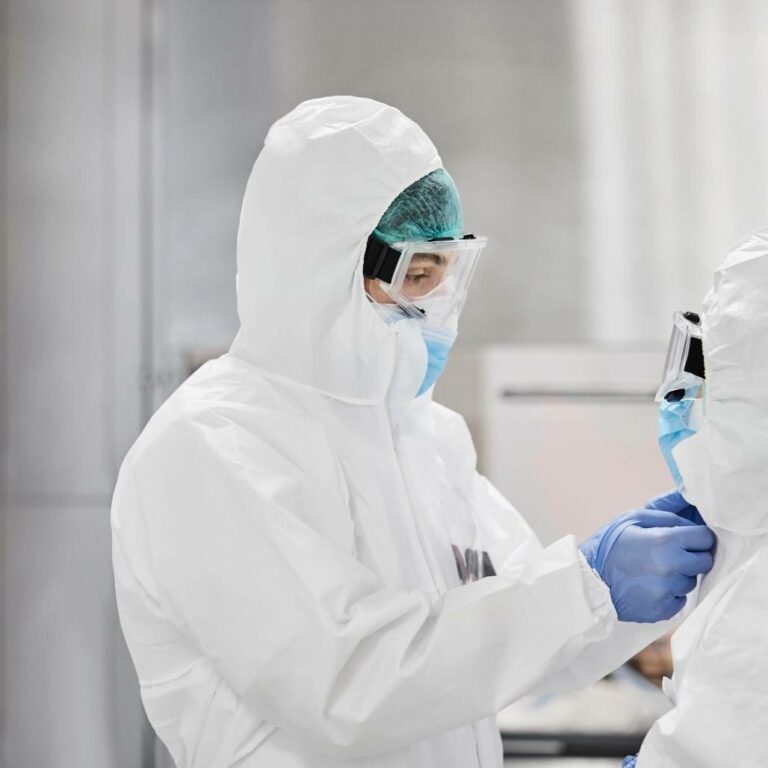Types of Disposable Coveralls
Published by Harmony Lab & Safety Supplies on Jan 02, 2024
Disposable coveralls protect the wearer against liquid and particulate hazards. Everyday household use includes painting, mold remediation, and construction projects while industrial applications include pharmaceutical manufacturing and cleanroom environments.
What type of coveralls should you get? Use our table of contents below to find the disposable coverall material and style that fits your hazard.
3 Benefits of Disposable Coveralls
Convenient Protection
As opposed to reusable coveralls, you can easily avoid contamination by disposing of soiled jumpsuits.
Cost Effective
Basic protection with coveralls is cost effective and your workforce can be suited up without cutting into profits.
Highly Versatile
Coveralls can pair with other safety gear such as disposable gloves and full-face respirators.
Here you can find the standard level of CE-certified protection provided by different disposable coveralls.
- Type 1 -EN 943 sets standards for gas and vapor protection.
- Type 3 – EN 14605 sets standards for liquid protection that may tear the material.
- Type 4 – EN 14605 sets standards for liquid protection that may degrade the material.
- Type 5 – EN 13982 sets standards for dry particulate protection.
- Type 6 – EN 14605 sets standards for liquid aerosol protection.
Disposable Coverall Materials
What are the types of materials for disposable coveralls?
Microporous
Microporous coveralls have two layers of spun-bound polypropylene that are the base for a microporous film. The combination of the film and polypropylene provides splash, vapor, and particulate protection.
The polypropylene base layers act as a membrane with pores of less than 2 nanometers, meaning most particulates can’t penetrate the material barrier. Air and other gases can breathe, keeping the wearer comfortable.
Microporous coveralls are not fire-proof and are not suitable for hazards in extreme conditions. The seams ensure consistent protection.
Microporous coveralls are suitable for laboratory, forensic science, cleanroom, food processing, medical and viral protection, and paint spraying and industrial hazards.
Polyethylene Coated
Polyethylene-coated coveralls benefit from the plastic PE coating that protects against liquids and oil-based hazards found in painting. The plastic coating offers superior protection against fluids and can replace more expensive Tyvek coveralls when essential protection is needed.
PE-coated coveralls are suitable for paint spraying, pesticide handling, food processing, general maintenance, and medical fields needing liquid protection.
Polypropylene
Polypropylene coveralls have a single layer of material. The downside of polypropylene is the lack of liquid and splash protection found in microporous and PE-coated materials. Polypropylene coveralls are affordable.
SMS
SMS coveralls are made from a non-woven material in 3 layers: spun-bond polypropylene, melt-blown polypropylene, and spun-bond polypropylene. These 3 layers combine to protect the wearer from dust, particulate, and liquid hazards. SMS is breathable and common in industrial manufacturing, construction, general cleanup, and pharmaceutical labs.
Tyvek
Tyvek coveralls feature a unique material called high-density polyethylene which provides one of the highest levels of protection found on the market. Particulates and dust bigger than 1-micron won’t penetrate high-density polyethylene, but air will pass through for comfort. This high-performance material has a range of styles to choose from to suit your hazard.
Where can you find disposable coveralls?
You will find coveralls and jumpsuits at Harmony Lab & Safety Supplies that keep your employees safe.
We have decades of experience providing safety gear with US-based customer support. Please feel free to reach out if you have any questions. We want to get you the supplies you need!

